Market
Ethereum Struggles Despite Bybit’s Reserve Recovery

Ethereum (ETH) has fallen more than 8% in the last 24 hours and over 22% in the past 30 days, reflecting a bearish market sentiment. The price was already in decline before the Bybit hack, which further impacted market sentiment.
Although Bybit has since recovered 84% of its reserves, ETH’s price remains under pressure. With key resistance at $2,850 and no break above $2,900 since February 2, Ethereum’s outlook remains uncertain as bearish indicators continue to dominate.
Bybit Is Recovering Its ETH Reserves After the Hack
Ethereum’s supply on Bybit experienced a dramatic decline after the hack, plummeting from 443,000 ETH to just 20,250 ETH in a single day.
This sudden drop triggered panic selling pressure on ETH and also on BTC and other coins, as market participants feared a potential liquidity crisis.
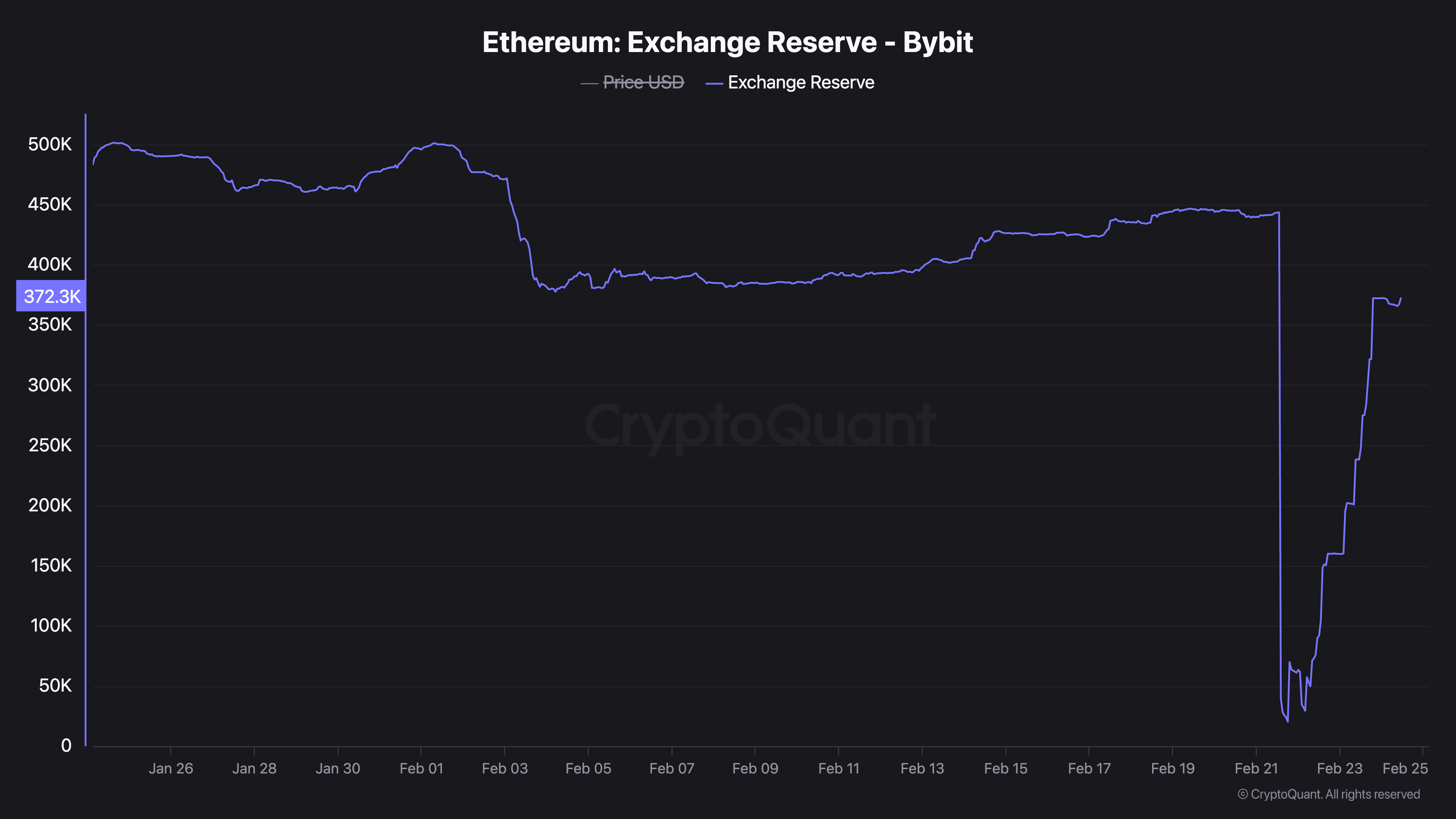
The sharp decrease in reserves heightened uncertainty, leading to widespread speculation about the aftermath. Some users suggested that Bybit might be forced to buy back ETH to restore its reserves, potentially creating strong buying pressure.
Since February 22, Bybit’s ETH reserves have shown significant recovery, surging from 29,000 ETH to 372,000 ETH by February 24, which accounts for 84% of its pre-hack reserves.
The market’s initial panic selling appears to have been temporary, and the rebound in reserves could lead to renewed buying interest in ETH. However, Ethereum’s price has not recovered to levels before the hack yet.
Indicators Show No Signs of a Bullish Momentum
The Relative Strength Index (RSI) for Ethereum was recovering after the Bybit hack, reaching 63.2 yesterday, indicating strong buying momentum.
However, it has since dropped sharply and is now at 43, signaling a significant shift in market sentiment. RSI is a momentum oscillator that measures the speed and change of price movements, ranging from 0 to 100.
Typically, an RSI above 70 suggests that an asset is overbought, indicating potential selling pressure, while an RSI below 30 indicates that an asset is oversold, potentially signaling buying opportunities.
An RSI between 30 and 70 is generally considered neutral, with movements within this range reflecting normal market fluctuations.

Ethereum’s RSI dropping from 63.2 to 43 in just one day suggests a rapid shift from bullish to bearish sentiment. This significant decline could indicate increased selling pressure or reduced buying interest, possibly due to lingering concerns about the aftermath of the Bybit hack.
A drop to 43 also brings RSI closer to the oversold territory, which, if continued, could indicate a further bearish trend. However, if buying interest resumes, the RSI could stabilize or even rebound, suggesting a potential recovery.
Ethereum’s DMI chart shows the ADX at 18.3, down from 21.4 yesterday, indicating weakening trend strength. An ADX below 20 suggests a lack of clear momentum, aligning with Ethereum’s ongoing downtrend.

Meanwhile, the +DI dropped from 30.4 to 20, showing decreased buying interest, while the -DI rose from 12.3 to 22.9, signaling increased selling pressure.
The crossover of -DI above +DI confirms bearish dominance, suggesting continued downward pressure on Ethereum’s price.
The weakening ADX, combined with rising -DI, points to a declining trend that may persist unless buying momentum returns. This could result in further price drops or sideways movement in the short term
Ethereum Price Has Been Below $2,900 For Three Weeks
Ethereum has struggled to break above the $2,850 resistance, which has been repeatedly tested in recent weeks. If the current downtrend continues, ETH could test the support at $2,551, and if that level fails, it might drop further to $2,159.
Notably, Ethereum hasn’t broken above $2,900 since February 2, highlighting strong resistance in this range.
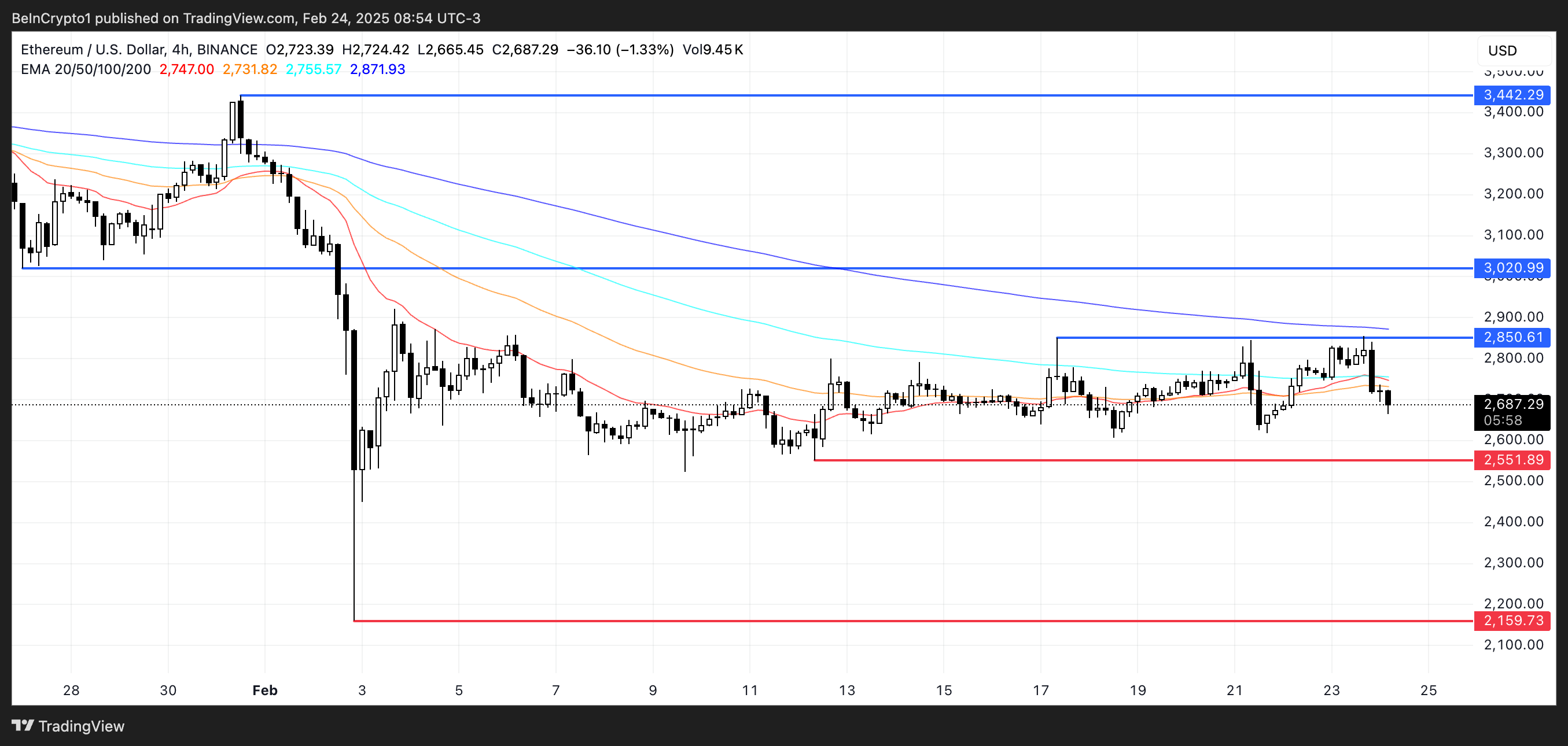
However, if Bybit successfully restores its reserves to pre-hack levels, this could boost positive sentiment for ETH. In this scenario, an uptrend might retest the $2,850 resistance, and if broken, Ethereum price could rise to $3,020.
Should momentum continue, the next target would be $3,442. A break above $2,900 would be significant, as ETH has struggled with this level since early February, potentially signaling a bullish reversal.
Disclaimer
In line with the Trust Project guidelines, this price analysis article is for informational purposes only and should not be considered financial or investment advice. BeInCrypto is committed to accurate, unbiased reporting, but market conditions are subject to change without notice. Always conduct your own research and consult with a professional before making any financial decisions. Please note that our Terms and Conditions, Privacy Policy, and Disclaimers have been updated.
Market
PI Token Price Faces Bearish Pressure, Risking a Drop to $0.40

PI has been on a steady downtrend since February 26, shedding 72% of its value as bearish sentiment continues to weigh on the token.
Bearish pressure continues to mount on the PI token, suggesting that it may be poised to enter a new phase of decline.
PI Network Risks Fresh Decline
An assessment of the PI/USD one-day chart reveals that token holders remain steadfast in their distribution. At press time, PI’s Balance of Power (BoP) is negative, reflecting the selling pressure in the market.
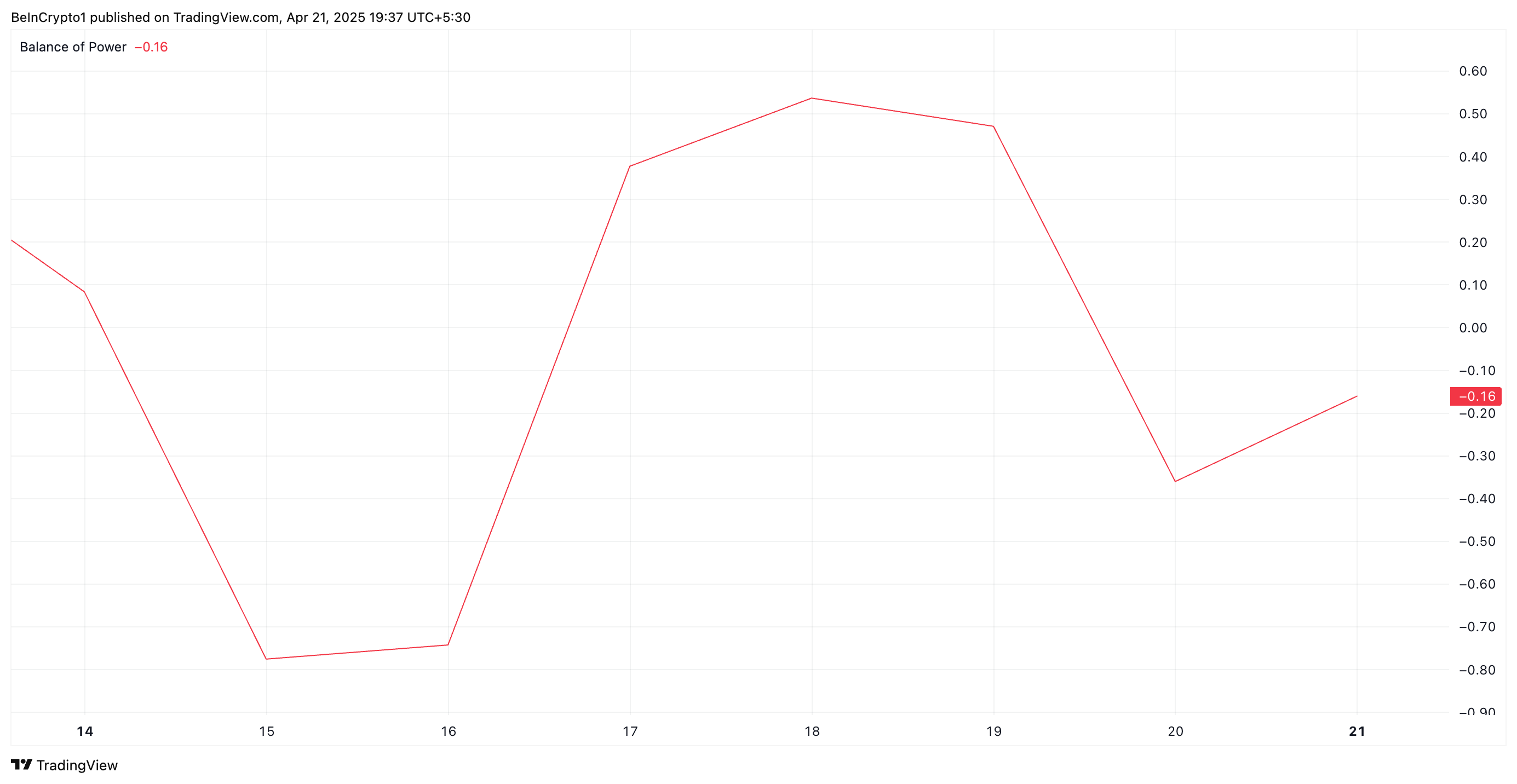
The BoP indicator measures the strength of buying versus selling pressure by comparing the close price to the trading range within a given period. When BOP is negative like this, it indicates that sellers are dominating the market, suggesting downward pressure on the asset’s price.
Further, the setup of PI’s Chaikin Money Flow (CMF) supports this bearish outlook. At press time, this is below the central line at -0.12.
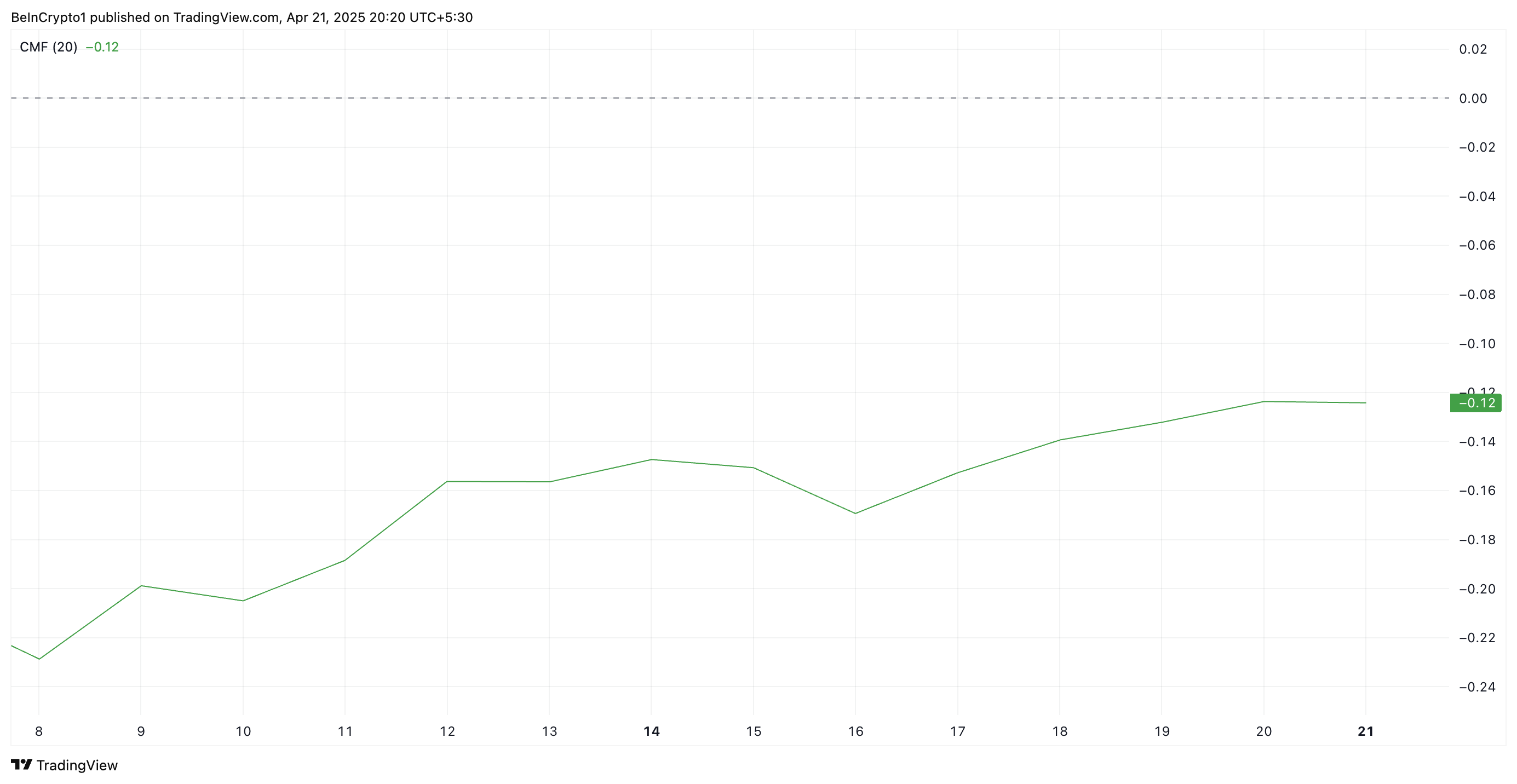
The CMF indicator measures an asset’s buying and selling pressure. A negative CMF reading suggests that the asset is experiencing more selling pressure than buying pressure. This means PI traders are distributing rather than accumulating. This signals bearish sentiment and confirms the downward momentum in the token’s price.
Sellers Tighten Grip on PI, But Recovery to $1.01 Still on the Table
At press time, PI trades at $0.63, below the dynamic support formed above it at $0.93 by its Super Trend indicator.
The Super Trend indicator helps traders identify the market’s direction by placing a line above or below the price chart based on the asset’s volatility.
When an asset’s price trades below the Super Trend line like this, it signals a bearish trend and hints at potential decline. If PI’s decline strengthens, it could revisit its all-time low of $0.40.
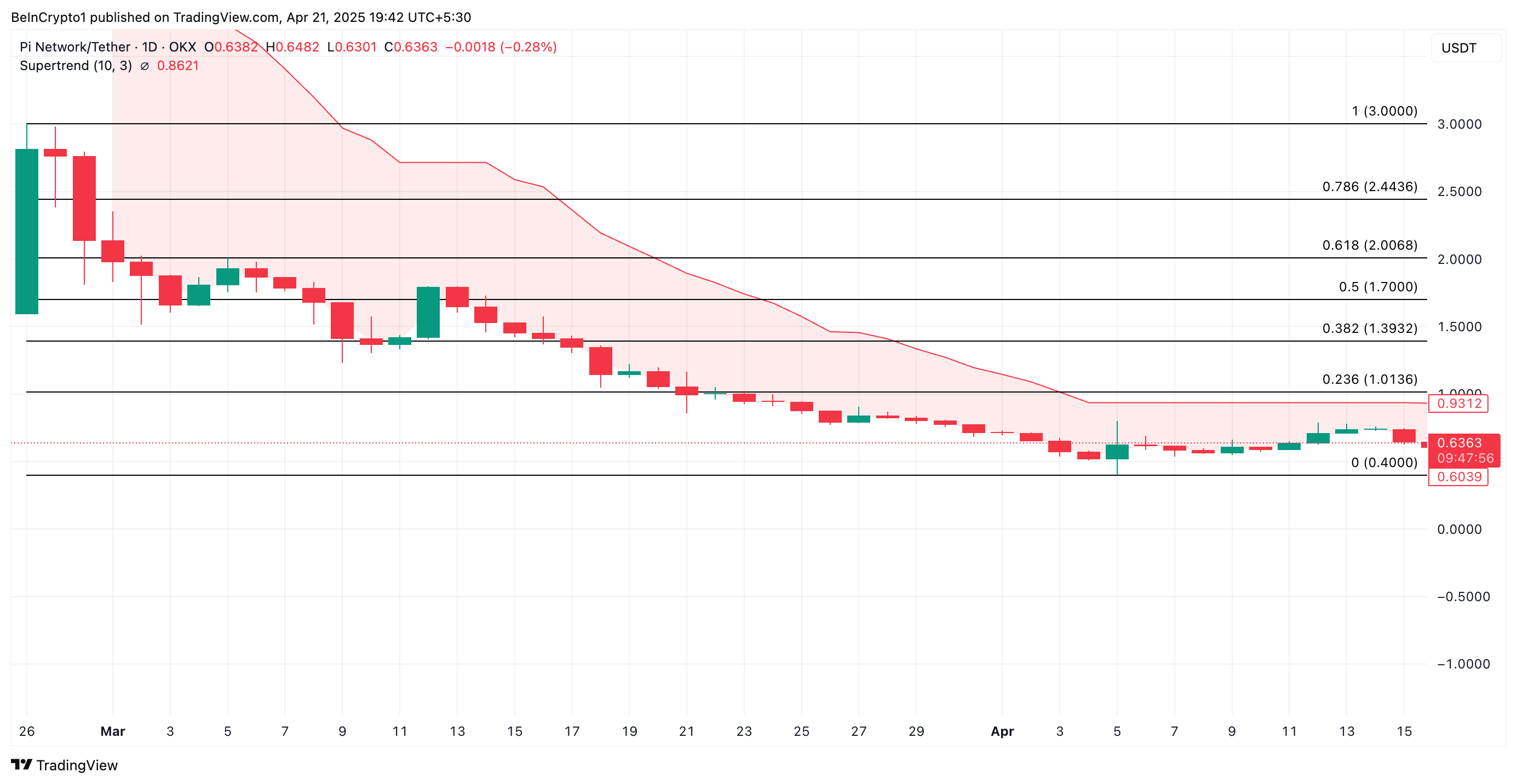
However, if demand returns to the PI market, its price could break above the resistance at $0.86 and surge to $1.01.
Disclaimer
In line with the Trust Project guidelines, this price analysis article is for informational purposes only and should not be considered financial or investment advice. BeInCrypto is committed to accurate, unbiased reporting, but market conditions are subject to change without notice. Always conduct your own research and consult with a professional before making any financial decisions. Please note that our Terms and Conditions, Privacy Policy, and Disclaimers have been updated.
Market
Circle, BitGo, and Others Eye Bank Charters in US


With support from Trump’s White House and easing regulations, firms like Circle and BitGo are pursuing becoming full-fledged financial institutions.
Reports indicate a new wave of crypto companies knocking on the once-closed doors of the American banking system. This time, someone is listening.
Crypto Firms Seek Bank Charters as Wall Street’s Doors Reopen
After years of being sidelined, crypto companies are coming back, this time through the front door of the US banking system.
Citing sources familiar with the matter, the Wall Street Journal revealed that several major players, including Circle and BitGo, are preparing to apply for bank charters or financial licenses.
Traditional banks are also responding to the shift. US Bancorp is re-launching its crypto custody program via NYDIG, while Bank of America (BofA) said it would issue its stablecoin once the legal framework is in place.
Even global giants are watching closely. A consortium including Deutsche Bank and Standard Chartered is evaluating how to expand crypto operations into the US.
While details remain scarce, the interest signals that crypto is no longer just a niche but a competitive frontier.
These firms reportedly aim to operate with the same legitimacy and access as traditional lenders. This includes holding deposits, issuing loans, and launching stablecoins under regulatory supervision.
The timing is not random. A sharp pivot in federal policy, driven by President Trump’s pledge to make the US a Bitcoin superpower, has reopened regulatory pathways once shut after the FTX collapse.
In parallel, Congress is advancing stablecoin legislation requiring issuers to secure federal or state licenses.
The push for bank status comes amid a broader effort to legitimize crypto within US finance. Earlier this year, regulators rolled back key restrictions. Among them, the SEC’s controversial SAB 121, which had blocked banks from holding crypto on behalf of clients.
Meanwhile, Federal Reserve (Fed) Chair Jerome Powell affirmed that banks could serve crypto customers provided proper risk management strategies exist.
In another regulatory green light, the Office of the Comptroller of the Currency (OCC) clarified that banks can offer stablecoin and custody services. However, this is provided they comply with established banking rules.
These signals have emboldened crypto firms previously kept at arm’s length. Anchorage Digital, the only US crypto-native firm with a federal bank charter, says the regulatory lift is massive but worth it.
“It hasn’t been easy… the whole gamut of regulatory and compliance obligations that banks have can be intertwined with the crypto industry,” Anchorage CEO Nathan McCauley reportedly admitted.
McCauley cited tens of millions in compliance costs. Nevertheless, Anchorage has since collaborated with BlackRock, Cantor Fitzgerald, and Copper for high-profile custody and lending programs.
BitGo, which will reportedly custody reserves for Trump-linked stablecoin USD1, is nearing a bank charter application.
Circle, the issuer of USDC, is also pursuing licenses while fending off competition, just like Tether. This is a traditional finance (TradFi) venture into stablecoins.
The firm delayed its IPO this month, citing market turmoil and financial uncertainty. However, insiders say regulatory clarity remains a top priority.
Firms like Coinbase and Paxos are exploring similar routes, considering industrial banks or trust charters to expand their financial offerings legally.
At the policy level, venture firm a16z has called on the SEC to modernize crypto custody rules for investment firms, reflecting the industry’s hunger for clarity and parity.
Disclaimer
In adherence to the Trust Project guidelines, BeInCrypto is committed to unbiased, transparent reporting. This news article aims to provide accurate, timely information. However, readers are advised to verify facts independently and consult with a professional before making any decisions based on this content. Please note that our Terms and Conditions, Privacy Policy, and Disclaimers have been updated.
Market
BNB Springs Back From $531 With Unshaken Bullish Conviction

My name is Godspower Owie, and I was born and brought up in Edo State, Nigeria. I grew up with my three siblings who have always been my idols and mentors, helping me to grow and understand the way of life.
My parents are literally the backbone of my story. They’ve always supported me in good and bad times and never for once left my side whenever I feel lost in this world. Honestly, having such amazing parents makes you feel safe and secure, and I won’t trade them for anything else in this world.
I was exposed to the cryptocurrency world 3 years ago and got so interested in knowing so much about it. It all started when a friend of mine invested in a crypto asset, which he yielded massive gains from his investments.
When I confronted him about cryptocurrency he explained his journey so far in the field. It was impressive getting to know about his consistency and dedication in the space despite the risks involved, and these are the major reasons why I got so interested in cryptocurrency.
Trust me, I’ve had my share of experience with the ups and downs in the market but I never for once lost the passion to grow in the field. This is because I believe growth leads to excellence and that’s my goal in the field. And today, I am an employee of Bitcoinnist and NewsBTC news outlets.
My Bosses and co-workers are the best kinds of people I have ever worked with, in and outside the crypto landscape. I intend to give my all working alongside my amazing colleagues for the growth of these companies.
Sometimes I like to picture myself as an explorer, this is because I like visiting new places, I like learning new things (useful things to be precise), I like meeting new people – people who make an impact in my life no matter how little it is.
One of the things I love and enjoy doing the most is football. It will remain my favorite outdoor activity, probably because I’m so good at it. I am also very good at singing, dancing, acting, fashion and others.
I cherish my time, work, family, and loved ones. I mean, those are probably the most important things in anyone’s life. I don’t chase illusions, I chase dreams.
I know there is still a lot about myself that I need to figure out as I strive to become successful in life. I’m certain I will get there because I know I am not a quitter, and I will give my all till the very end to see myself at the top.
I aspire to be a boss someday, having people work under me just as I’ve worked under great people. This is one of my biggest dreams professionally, and one I do not take lightly. Everyone knows the road ahead is not as easy as it looks, but with God Almighty, my family, and shared passion friends, there is no stopping me.
-

 Market23 hours ago
Market23 hours agoTokens Big Players Are Buying
-

 Market22 hours ago
Market22 hours agoDogecoin Defies Bullish Bets During Dogeday Celebration
-

 Bitcoin10 hours ago
Bitcoin10 hours agoUS Economic Indicators to Watch & Potential Impact on Bitcoin
-

 Altcoin22 hours ago
Altcoin22 hours agoExpert Predicts Pi Network To Reach $5 As Whales Move 41M Pi Coins Off Exchanges
-

 Market20 hours ago
Market20 hours agoWill XRP Break Support and Drop Below $2?
-

 Bitcoin20 hours ago
Bitcoin20 hours agoBitcoin LTH Selling Pressure Hits Yearly Low — Bull Market Ready For Take Off?
-

 Bitcoin17 hours ago
Bitcoin17 hours agoHere Are The Bitcoin Levels To Watch For The Short Term
-

 Market13 hours ago
Market13 hours agoBitcoin Price Breakout In Progress—Momentum Builds Above Resistance
























